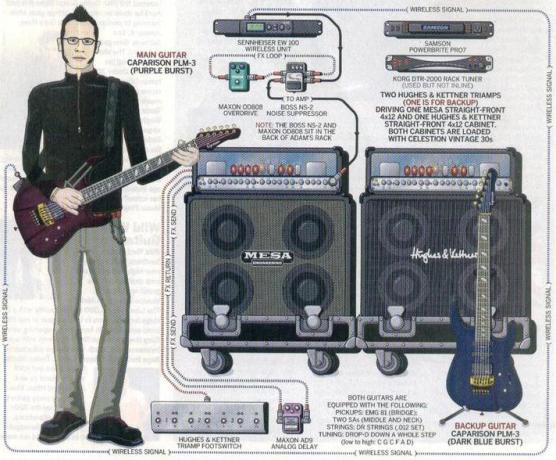1) Wireless has nothing to do with this. Wireless goes from the guitar to the pedalboard (if there is one) and into the amplifiers. The amps will see a normal signal through a normal cable, cause that's all they know. A clean/dirty setup like you are describing can be done a multitude of ways.
2) Absolutely, read on for suggestion of what product does this. Although there are many ways to skin this cat. Most guitarists will recommend the ToneBone Amp Switcher though. Also, if the amps used are tube or not (most, in this case will be tube amps) they will require special attention, or they will literally fry themselves up.
Let's define channels:
A channel on a amp pertains to a certain sound. The most basic channel switching amp will usually have 2 channels. One clean, and one distorted. The distorted one (on a tube amp) will amplify the signal more, causing it to distort before sending it to the power section of the amp where it "gets louder". The clean section of the amp will have less amplification (and therefore clipping distortion) and therefore sound drastically different. This allows you to have the sound of multiple amps in one. Which is a good thing.
Most guitarists are comfortable with the channels on their amps. You'll find - more often than not - guitarists use channel switching to achieve sound differences. This is physically changing the preamp tubes (in tube amps - which are 99.5% of most professional guitar amps out there) circuit to actually add or remove distortion. EQ plays a role in this too.
See this image for an example that he uses for channel switching:

(This is an old example, out of a guitar magazine that used to do this all the time, you hardly see these anymore. Also, this "style" of amp rig is also not seen that much anymore. Why? Why not. More gear is more better to guitarists. Just ask any of us.)
In the case of a touring, headlining rock band, money isn't an issue. And the recording of their albums probably used many amps per song (or at least throughout the album) to achieve certain tones. The solution to achieving the sounds on the record is simply to bring the amps you used to get those tones. This is where heaving roadies and amp techs comes in handy. It saves your back. And your mind.

In the example above you'll see a head rack, or something similar to it. Each one of these amp heads are connected to a cabinet (usually mic'd offstage, to control bleed and stage volume/mix), although a product like the ToneBone Head Switcher can connect multiple heads to one cabinet, in fact it can do you're #2) requirement exactly. It's amazing. This can be tricky, and if done wrong - a very expensive tube amp repair, so beware! Doing this saves you from bringing multiple cabinets, but has a potential risk if done improperly.
In either case, pedals may be used. In the music that KE does, effects are used sparsely, if at all. That's just a stylistic choice they make when creating the music. Syncopated and distorted low-register riffs like they enjoy playing don't take well to common effects like Chorus, Delay and other time-based effects.
Caveat: certain effects can be used to create distortion, or mimic amps without needing to actually bring, ship and maintain them. But that's not any fun for guitarists. Guitarists love complexity, old wives tales, and being as difficult as possible.
When you go to your next live show, check out finely what the guitarist(s) have. It's kinda a hobby of ours. If they're hauling their own stuff (and playing out on a frequent basis) you'll see a small number of amps, 1 or maybe 2 if they're feeling happy. Amps, even heads, are very heavy. They'll have a conservative pedalboard and be able to get a lot of great sounds out of it all. If they're paying someone to do it for them, you'll see their entire gear room on display. And that's cool too, cause they don't have to lift an 80-pound amp head night-after-night. They'll have their large pedalboard out too, spaceship lighting and all.
I'm so sorry that was long-winded. This stuff gets my juices going.


